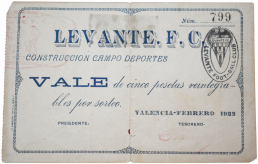The document reveals the construction of the Campo de La Cruz located on the Camino Hondo del Grao. We return to Valencia at the beginning of the 1920s to contextualise this event. Football began to acquire transcendence and to take hold in the imagination of the Valencians. It was in this ecosystem that Levante F.C. was established. It was a historic milestone for the footballing society of the Poblados Marítimos. Perhaps Levante F.C. faced at that time one of the most considerable challenges as an entity dedicated primarily to the practice of sport. It was not an issue that lacked an imprint. Levante established an allegorical and symbolic space in its struggle inside the pitch. It was a physical and identifying point, but at the same time endowed with a high spiritual content to fight for victory.
It is a donation made by Miguel Solana. This loyal Blue and Reds’ fan, who has fought countless battles, keeps a huge and substantial piece of Levante’s history like gold in his private home. LEVANTE F.C. CONSTRUCCIÓN CAMPO DE DEPORTES” reads at the top. It is a VOUCHER of five pesetas, refundable by lottery, for the construction of the Campo de La Cruz. The ticket is dated in Valencia in February 1922 and bears, in each corner, the characteristic and distinctive stamps of Levante F.C. at the start of the 1920s. Levante Foot-Ball Club manifiesta, following the English terminology of the historical period. This kind of receipt is signed by the treasurer and the president of the Poblados Marítimos club. The receipt is numbered. It is number 799.
The voucher offers a wealth of additional information. For one thing, it introduces Levante F.C. fans to a complicated operation in economic terms. The social mass sponsored the construction of the Campo de La Cruz by obtaining these vouchers worth five pesetas. In this sense, a democratising process can be seen in the construction of this stadium. The board of the marine club leased some land located on the Camino Viejo del Grao, next to the Calle de la Conserva and the Travesía de La Cruz, to build a pitch to support the team’s sporting needs. It should be noted that Levante competed in the 1921-1922 season on the La Soledad pitch, owned by Gimnástico. The previous season, 1920-1921, they played their home matches at the Algirós ground.
In the summer of 1922 there is a dossier addressed to the Valencia City Council, Development Section, signed by Ángel Fernández, in his capacity as president of Levante F.C., with the aim of enclosing the Levante pitch with an enclosure wall. The request is accompanied by the signature of the architect Lorenzo Criado. The Campo de La Cruz was formally inaugurated on Sunday, 3 September 1922. Levante and Valencia (1-4) contested in the first confrontation of a facility that remained upright until the end of the 1950s, although Levante, after the merger with Gimnástico at the end of the Civil War, moved to the Vallejo ground to play their official matches.
